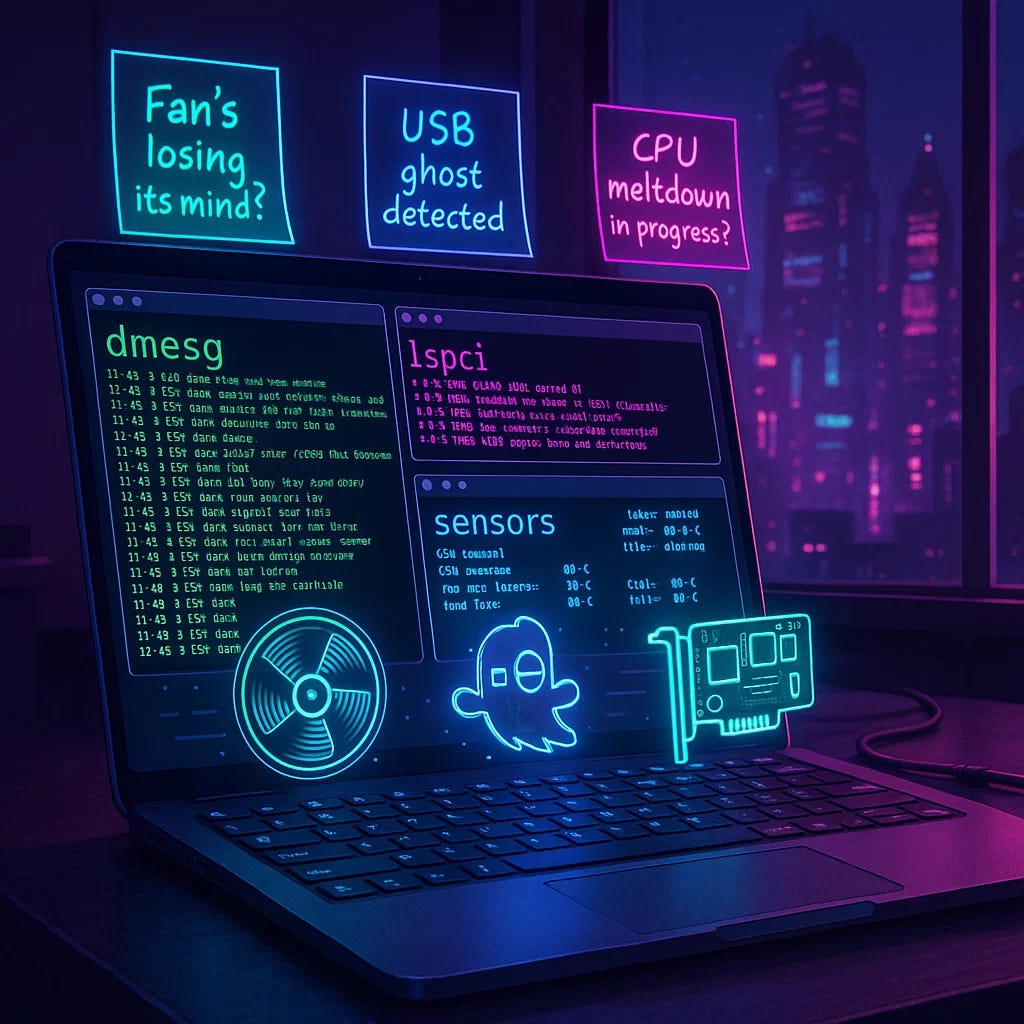Because your Linux box deserves more than “turn it off and on again.”
People say Linux is unbreakable, but let’s be honest — sometimes it acts like a drama queen. Your fans spin like a jet engine, a USB device pulls a vanishing act, or your CPU decides it’s a space heater.
The good news? Linux gives you the detective kit to catch the culprit in action. With the right commands, you can sniff out problems, fix them before they explode, and casually claim “I’m basically an IT wizard” to your friends.
Why Should You Care?
Picture this: you’re working away, and suddenly your fans sound like a jet engine, your USB mouse stops responding, or your server won’t boot after an update.
Do you:
- Panic?
- Search Stack Overflow in desperation?
- Whip out a few trusty Linux commands like a seasoned pro?
This guide is here to make sure you confidently pick Option 3 (and maybe impress your friends with your “cool hacker” terminal skills).
1. System Monitoring and Diagnostics
Your Linux system is like a teenager — it won’t tell you what’s wrong unless you ask the right way.
dmesg – The System’s Gossip Column
Ever wish you could hear all the behind-the-scenes drama? dmesg spills it all—hardware issues, driver fights, and weird errors.
- Scenario: Your Wi-Fi card suddenly disappears. Run:
dmesg -l err -H- It’ll show errors in a nice human-readable format.
Pro Tip: dmesg -L adds colors, because if you’re going to read errors, they might as well be in style.
lm_sensors – The Thermometer for Your PC
This is for when your laptop feels like it could cook eggs.
- Scenario: You’re rendering a video and hear fans screaming. Run:
lm_sensors- If your CPU temp reads like a summer day in the Sahara, you know why your laptop’s yelling.
ipmitool – The Server’s Remote Control
Think of it as texting your server to ask, “You good?”
- Scenario: You’re miles away and need to check if your server is even on. Run:
ipmitool chassis status- Bonus: You can power it off remotely if it’s misbehaving — like a digital timeout.
2. Hardware Inventory Commands
Sometimes you need to play detective and figure out what’s actually plugged in.
lspci – The Guest List for PCI Devices
- Scenario: You’re not sure if your new graphics card is even showing up. Run:
lspci -tv- It’s like checking the guest list to make sure the VIP actually arrived.
lsusb – The USB Party Roll Call
- Scenario: Your keyboard suddenly ghosts you (literally). Run:
lsusb- If it’s not listed, your keyboard isn’t even at the party.
lshw – The Full-Body X-Ray
- Scenario: Someone asks, “What specs does your machine have?” and you want to flex. Run:
sudo lshw -short- Careful though — it lists everything, so don’t get lost reading it like a tech novel.
3. Initrd Management
Before Linux fully boots, there’s a little “pre-show” called the initrd. This is where the drivers get ready.
mkinitrd – The Old-School Boot Prepper
- Scenario: You’re on an older system and need to load specific drivers before boot. Example:
mkinitrd --preload=module_name --with=driver_name -f --nocompress /boot/initrd-x.y.img x.ydracut – The Modern Boot Butler
- Scenario: You updated your kernel and now nothing works.
dracut --add-drivers "driver1 driver2" initramfs.img $(uname -r)- It’s like asking a butler to pack exactly what you need for a trip — no extra baggage.
4. Custom Hardware & Special Workloads
Linux is everywhere — servers, IoT devices, and yes, your smart fridge that won’t stop emailing you.
- Embedded Systems: Like heart-rate monitors, factory machines, or smart doorbells. They often run lightweight Linux or real-time OS to react fast.
- GPU Power: Not just for gamers. Used in AI, crypto mining, and simulations.
- Scenario: You suspect your GPU is overworked. Run:
nv/amd top- If your VRAM’s at 99%, it’s time to close those 42 Chrome tabs.
Final Thought
These commands are like that friend who can fix your Wi-Fi by “just clicking around.” The difference? Now you’re that friend. And honestly, your Linux box will love you for it.
